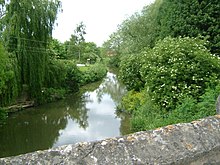River Beult
| River Beult | |
|---|---|

River Beult at Yalding
|
|
| Basin features | |
| Main source | several sources west of Ashford TQ 980 390 51°06′57″N 0°49′48″E / 51.115933°N 0.830014°E |
| River mouth |
River Medway at Yalding TQ 693 503 51°13′36″N 0°25′32″E / 51.226666°N 0.425660°ECoordinates: 51°13′36″N 0°25′32″E / 51.226666°N 0.425660°E |
The River Beult (/ˈbɛlt/ BELT) is a tributary of the River Medway. It has several sources west of Ashford, including one at Woodchurch. It then flows through Headcorn. At Hunton, 7 furlongs (1.4 km) above Yalding it is joined by the major stream of the River Teise. Town bridge lies 10 1⁄4 miles (16.5 km) from Allington, it is the longest mediaeval bridge in Kent. The river enters the Medway at Yalding. The River Beult is crossed by the railway between Headcorn and Staplehurst. The bridge was the scene of the Staplehurst rail crash in 1865 in which Charles Dickens was involved.
The River Beult was subject to a Land Drainage Improvement Scheme in the 1930s. This led to the river being widened, deepened and straightened from Smarden to Yalding. Despite this action the river is designated as a Site of Special Scientific Interest. It is one of the few clay rivers in England and Wales to retain much of its characteristic flora. It hasn't been heavily embanked like most clay rivers found in the midlands, although the majority of trees were removed. The lack of shade coupled with retained areas of grazing means there are many wildlife rich margins to the river, with nearly 100 different species of aquatic and marginal plants recorded.
...
Wikipedia
